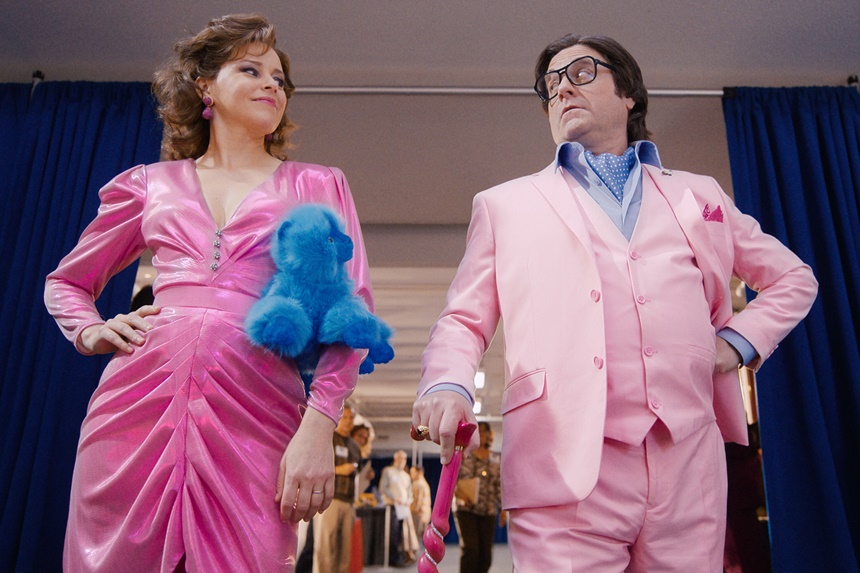The Beanie Bubble
⭐️ ⭐️ ⭐️
Rating: R
Run Time: 1 hour 50 minutes
Stars: Zach Galifianakis, Elizabeth Banks, Sarah Snook, Geraldine Viswanathan
Writers: Kristin Gore, Zac Bissonnette
Directors: Kristin Gore, Damian Kulash
In Theaters now; Streaming on Apple+ July 28
Bigger than Cabbage Patch Kids and more ubiquitous than the Hula-Hoop, Beanie Babies were not just a 1990s toy craze: Those adorable, bean-filled critters with names like Sorbet the Rabbit and Knuckles the Pig raised social and economic waves that ripple to this very day.
Of course, it’s a sure bet that direct-to-consumer websites would have conquered the Internet even if the Beanie Babies hadn’t gotten there first. Likewise, eBay would still be with us even without the early boost it got from those insanely motivated Beanie Baby collectors, who once drove the bidding for a button-eyed Bubbles the Fish Beanie up to $129,000.
Unbridled obsession has always made for good — and great — cinema, from Phantom of the Opera through Citizen Kane all the way to Fatal Attraction and beyond. The Beanie Bubble, a lightly fictionalized take on the rise and fall of the Beanie phenomenon, taps into that manic movie tradition. And while the narrative structure formulated by a first-time feature-making team at times seems as squishy as Lucky the Ladybug (currently $200 on eBay), a fine cast creates a gallery of fully realized and often compelling characters.
Zack Galifianakis stars as Ty Warner, the “Ty” whose company name appears on all 2,000-plus Beanie styles ever created. With oversized eyeglasses, a combed-back mane of hair and a face betraying the unintended consequences of too much cosmetic surgery, Galifianakis’s Ty is a bundle of flamboyant insecurity; a guy who at first blush seems as cuddly as Patti the Platypus ($10 on eBay) but who in the end has more sharp edges than Megatron.
Still, as the film’s prologue insists, this is the story not of Ty, but of the three women who made his plush empire possible. As portrayed here, they are analogs of actual women who helped steer the Beanie Baby phenomenon, but assigned fictional names and, we can only assume, some narrative liberties.
First up is Robbie (Elizabeth Banks), a former car garage mechanic who, through a chance encounter with the then-struggling toy entrepreneur, helps focus his attention toward creating floppy stuffed animals, then takes the financial reins, tending to the minutiae of commerce while Ty concentrates on creating cuddly characters.
It’s a successful partnership, but a volatile one, as Ty courts a string of lovers while continually taking credit for all of Robbie’s smart marketing moves. During one of their frequent splits, he becomes enamored with Sheila (Succession’s Sarah Snook), and most importantly, her two young daughters, who become his window to the children’s market he wants to dominate.
The biggest a-ha moment comes when one of the girls complains that she can’t fit Ty’s big, lovable stuffed animals into her backpack, inspiring him to downsize his designs and create (ta-daaa!) the Beanie Baby line.
Next comes Maya (Geraldine Viswanathan), the teenage daughter of Indian immigrants, who signs on as Ty’s receptionist but soon proves invaluable as his eyes and ears on the burgeoning digital landscape. It is Maya who creates Ty’s digital store (the first of its kind), and who envisions a limited-edition Beanie strategy that enables the company to create a “buy-it-now” culture among millions of fans. That, in turn, leads to the explosion of eBay transactions, pushing the secondary market higher and higher — and in turn goosing the company’s toy store sales (as noted in the film, in the mid-1990s Beanie Babies accounted for 10 percent of all eBay sales).
Ty may be the sun at the center of the film’s universe, but the three women are the planets — where all the life is. Banks has an actor’s gift for portraying hurt, anger, and scheming revenge all at the same time. Snook brings that quality of emerging realization that served her so well on Succession; an eye-narrowing “Oh, so that’s how it is” attitude that informs the viewer that she’s one step ahead of us — and her nemesis — virtually all the time. Viswanathan has perhaps the most challenging role, morphing seamlessly from an uncertain office temp to a woman who simply will not be trifled with.
As an exercise in storytelling, The Beanie Bubble seems unnecessarily convoluted. The narrative unfolds in an overlapping chronology, clicking to and fro from the 1980s to the 1990s and back, and then back again, and then back again. It appears co-writers Kristin Gore (who also co-directs) and Zac Bissonnette are intent on featuring all three women simultaneously, even though their unique contributions to the tale of Ty really only intersect at one precise moment. For the most part, the conceit doesn’t really work — until it does, in the final five minutes, with a payoff that makes the earlier confusion almost worth it.
Besides the compelling human stories at its center, The Beanie Bubble also examines, in unflattering light, the commodification of culture, a proudly American compulsion to monetize virtually everything. (How many people stashed sealed boxes of baseball cards in their attics, counting on them to finance their kids’ college educations?)
Pull up “Beanie Babies” on eBay these days, and you’ll still find the little guys for sale, sometimes at wildly inflated prices — apparently there are still a few sought-after stuffed unicorns out there — but mostly for modest sums of $10 or less. Whatever their cash value, there they are: sealed in locked plexiglass boxes, as if exposure to mere air will somehow further diminish their already dwindling value.
The Beanie Bubble burst nearly 30 years ago when, according to the film, Ty foolishly abandoned his “limited edition” strategy and flooded the market with Beanies. He remained rich as ever; his legions of collectors were left holding garbage bags full of virtually worthless cloth and plastic.
The Beanie Bubble is, in the end, a cautionary tale, waving us all off the next worthless big thing. If you believe that’s going to work, then I have some Bitcoin I’d like to sell you.
Become a Saturday Evening Post member and enjoy unlimited access. Subscribe now



